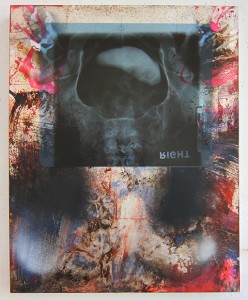Future Past Perfect
Nov. 7th – Dec. 13th, 2015
Featuring works by Michael Ambron, Mary Jones, Rachel Klinghoffer,
John O’Connor, & Bayne Peterson
Curated by Lauren Comito
Opening Reception: Saturday, November 7th, from 6-9pm
Projekt722 722 Metropolitan Ave, Brooklyn (Graham L train stop)
The Future Past Perfect indicates that an action will have been completed at some point in the future and simultaneously acknowledges that the action has already taken place. Future actions and forms are recontexualized versions of the past.
These artists are tied together by their interest in exploring the historical progression of totemic forms and seek out the invention of new forms for the future. In Philip K. Dick’s novel “The Man in the High Castle” handmade clay pots become the most valuable relics of a paranoid, fractured culture; a way people could hold on to a trace of their remembered humanity. The artists in Future Past Perfect are similarly invested in the evocation of the earliest signifiers of our human imagination. It is through these hand-created images and objects that we haptically connect, and communicate an empathetic moment through space and time.
As our own technologically driven age becomes one of increasing environmental pressure and cultural fragmentation, volumes of cultural works describing the end of our species have been created, suggesting an apocalypse that is played out with endless variety and circumstances. Clearly, this is something we can imagine. The insistence on materiality and the presence of physical form in these artists’ work suggests a post-apocalyptic present. The metaphor of the artifact that these artists use can range from digital fabrication to ancient cave painting, haiku to personal artifacts; all reflect an unsentimental awareness of our circumstances, and consider the basic elements of what might and could be essential.
Michael Ambron endures varied states of consciousness through his practice of painting; moving away from language and recognition/identification towards the outer margins of sensory perception. He uses the activity of painting to create a distance from the normative modes of engaging with reality, thereby offering the opportunity to experience rich and unusual altered states within his works.
Mary Jones‘ paintings find fragments of human form at the edge of recognition within an abstract process. Eschewing overt figuration, she makes reference to ancient, imaginary sculpture through a layered and intuitive approach. This fragmentation organizes the paintings as a gestalt, intended to evoke a connection with the earliest signifiers of our human imagination.
Rachel Klinghoffer explores an unconventional painting practice that engages with a laborious process of making and collecting. She incorporates personal items that range from lingerie to Hanukkah decorations. These articles evoke her personal connection to femininity, Judaism, romance, and other notions of painting – her works have become specimens, icons, and relics that are poked, prodded, stroked, rubbed, then pulled, torn, and broken apart.
John O’ Connor looks for patterns in the material present in everyday life. His most recent work involves ideas of political and social recurrence – the ways in which class structures are repeated across generations. O’Connor’s work investigates the ways in which information about human behavior is quantified and displayed, as a way to give specific form to the seemingly unexplainable actions people undergo.
Bayne Peterson‘s work is research-based and process-driven, drawing on a variety of narrative, historical moments, aesthetics and ephemera. He explores iterative series that take the form of multiple artifacts presented for study as either scale-shifted representations of the banal or updated modernist gestures. Using 3-D modeling tools within his process, Peterson investigates the limitations and failure of technology to articulate sculptural form.
Lauren Comito is an artist, curator and educator who lives and works in Brooklyn. She dedicates this exhibition to her late professor Frank Bramblett.
*Text written by Ross Klavan and Lauren Comito
